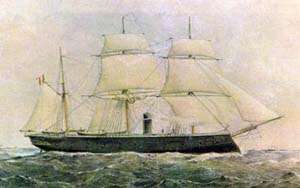Peruvian ironclad Independencia
Independencia was a broadside ironclad built in England for the Peruvian Navy during the mid-1860s. During the War of the Pacific of 1879–83, Independencia ran aground while pursuing the Chilean schooner Covadonga during the Battle of Punta Gruesa on 21 May 1879. The survivors were rescued by Huáscar and the wreck destroyed to prevent its capture.
 Independencia in 1866 | |
| History | |
|---|---|
| Name: | Independencia |
| Ordered: | 1 March 1864 |
| Builder: | Samuda Brothers, Poplar, London |
| Laid down: | 1864 |
| Launched: | 8 August 1865 |
| Completed: | December 1866 |
| Fate: | Destroyed after it ran aground during the Battle of Punta Gruesa, 21 May 1879 |
| General characteristics (as built) | |
| Type: | Broadside ironclad |
| Displacement: | 3,500 long tons (3,600 t) |
| Length: | 215 ft (65.5 m) (p/p) |
| Beam: | 44 ft 9 in (13.6 m) |
| Draught: | 21 ft 6 in (6.6 m) |
| Installed power: | 2,200 ihp (1,600 kW) |
| Propulsion: | 1 shaft, 1 Trunk steam engine |
| Sail plan: | Barque-rigged |
| Speed: | 12 knots (22 km/h; 14 mph) |
| Complement: | 250 |
| Armament: |
|
| Armor: | |
Description
Independencia was 215 feet (65.5 m) long between perpendiculars, had a beam of 44 feet 9 inches (13.6 m) and a draft of 22 feet 6 inches (6.9 m). The ship displaced 3,500 long tons (3,600 t). She had one trunk steam engine that drove her single propeller. The engine produced 2,200 indicated horsepower (1,600 kW) which gave the ship a speed of 12 knots (22 km/h; 14 mph).[1] For long-distance travel, Independencia was fitted with three masts[2] and barque rigged. She had a crew of 250 officers and crewmen.[3]
The ship was armed with four Armstrong 7-inch (178 mm), twelve 6-inch (152 mm) and four 30-pounder rifled, muzzle-loading guns. The 7-inch guns were on pivot mountings on the spar deck. She was a central-battery ironclad with the armament concentrated amidships.[3] Independencia was equipped with a ram at her bow and her hull was divided into three watertight compartments. The ship had a complete waterline armor belt 4.5 inches (110 mm) thick. Her battery was protected by armor plates equally as thick.[2]
Construction and career
Independencia was built by Samuda Brothers at their shipyard in Poplar, London. She was laid down in 1864 and launched on 8 August 1865 and completed in December 1866.[4] She had her boilers replaced in 1878. In February 1879, her armament was reinforced by a 9-inch (229 mm) rifled, muzzle-loading pivot gun in the bow and a 150-pounder Parrott gun in the stern, also on a pivoting mount.[2]
On 21 May, she was in pursuit of Covadonga after the Battle of Iquique and attempted to ram the Chilean ship as Independencia had only hit her opponent once thus far. The smaller Covadonga was hugging the coastline and one of her sharpshooters shot Independencia's helmsman just as the ship began to turning. Without anyone at the wheel, Independencia ran aground. Covadonga turned around and came up underneath Independencia's stern and raked her, forcing her surrender, until Huáscar drove off the Chilean ship. Independencia's casualties were four dead and eleven wounded; the ship was a total loss and only two 7-inch guns could be salvaged.[5] Huáscar loaded Independencia's crew aboard and blew up the wreck and set it on fire to prevent her capture.[2]
Notes
- Silverstone, p. 353
- "Some South American Ironclads", p. 204
- Gardiner, p. 418
- Silverstone, p. 392
- Greene & Massignani, pp. 307–08
References
- Gardiner, Robert, ed. (1979). Conway's All the World's Fighting Ships 1860–1905. London: Conway Maritime Press. ISBN 0-8317-0302-4.
- Greene, Jack & Massignani, Alessandro (1998). Ironclads at War: The Origin and Development of the Armored Warship, 1854–1891. Conshohocken, Pennsylvania: Combined Publishing. ISBN 978-0-938289-58-6.
- Silverstone, Paul H. (1984). Directory of the World's Capital Ships. New York: Hippocrene Books. ISBN 0-88254-979-0.
- "Some South American Ironclads". Warship International. Toledo, OH: Naval Records Club. VIII (2): 203–204. 1971.
- Wilson, Herbert Wrigley (1896). Ironclads in Action: A Sketch of Naval Warfare from 1855 to 1895. London: S. Low, Marston and company.